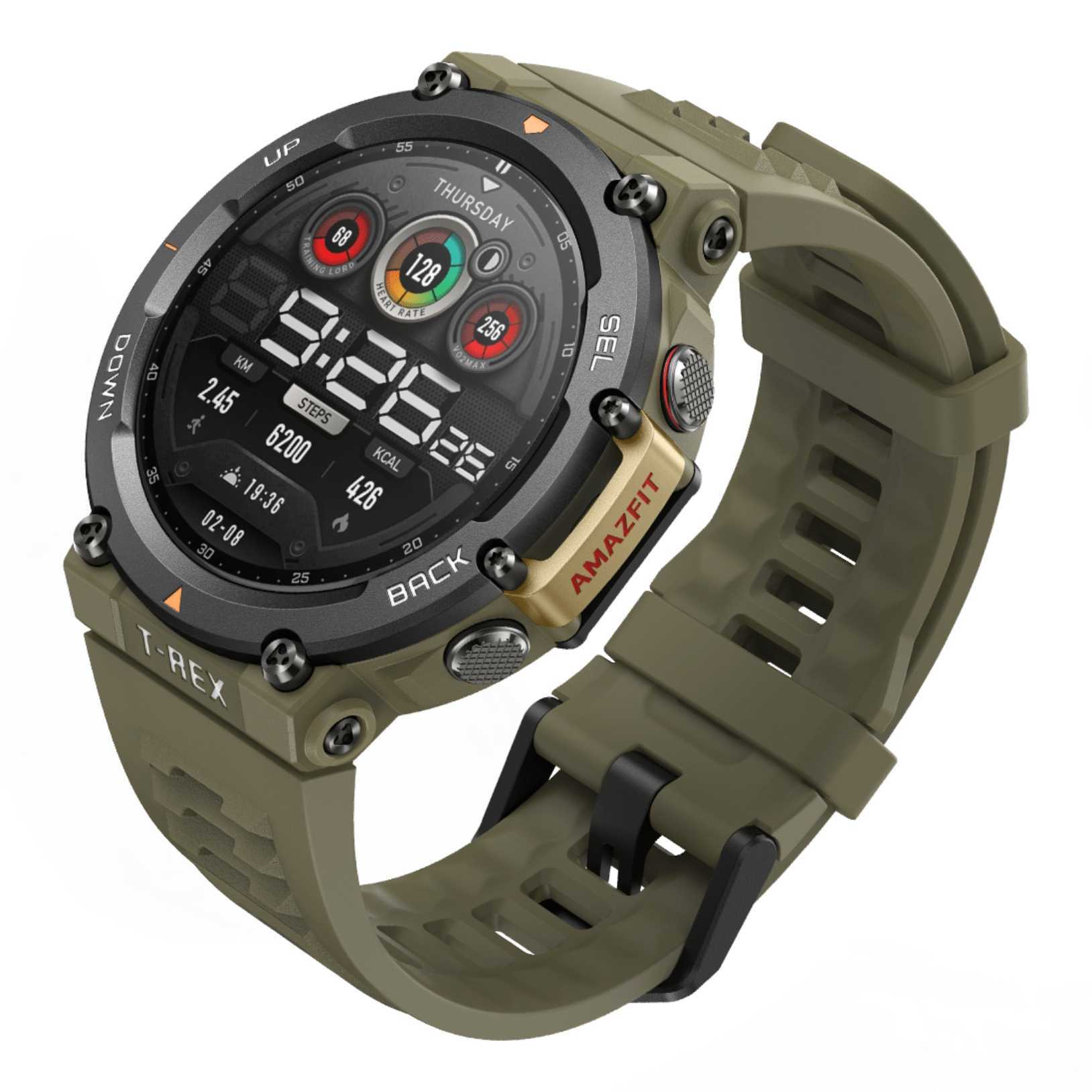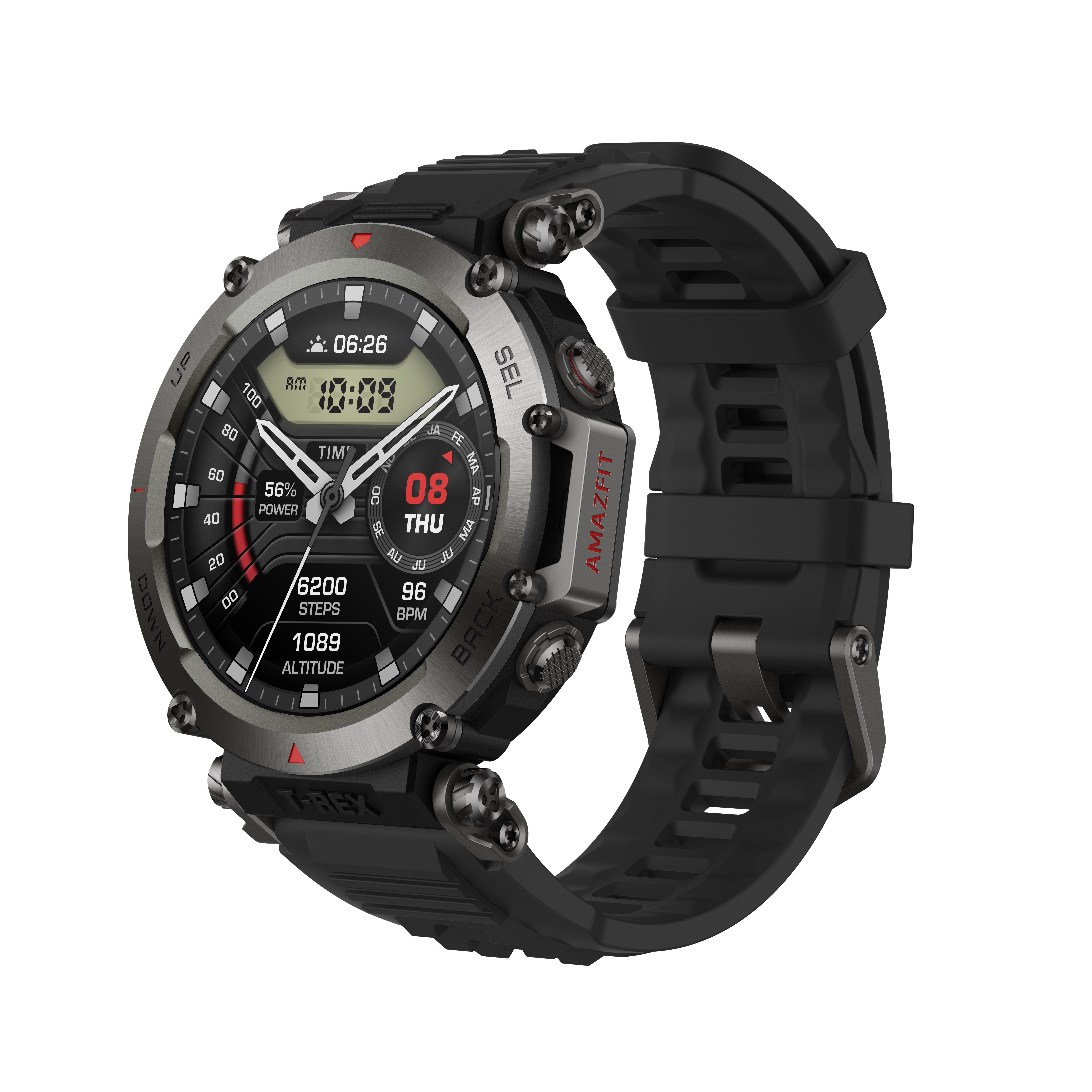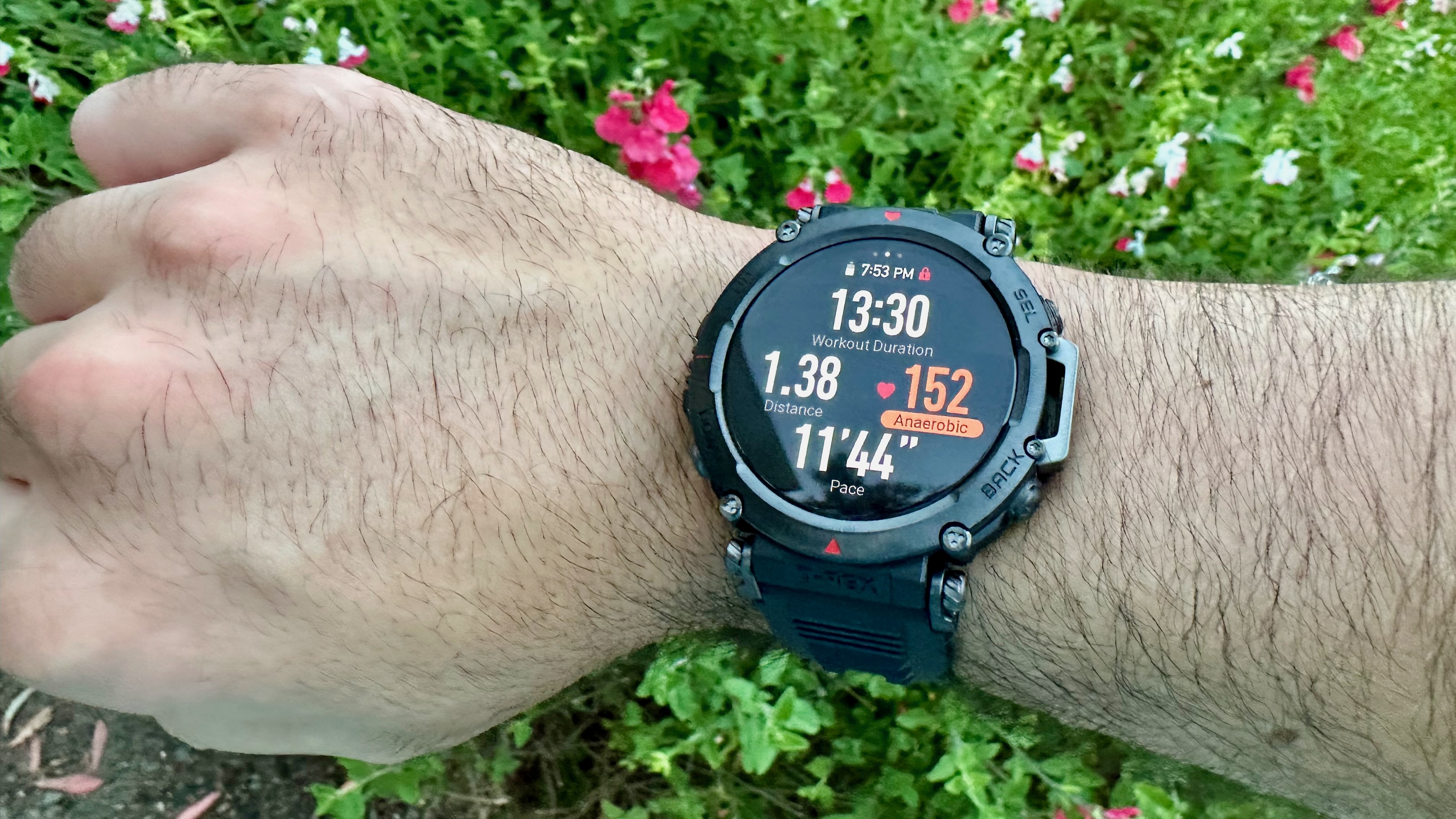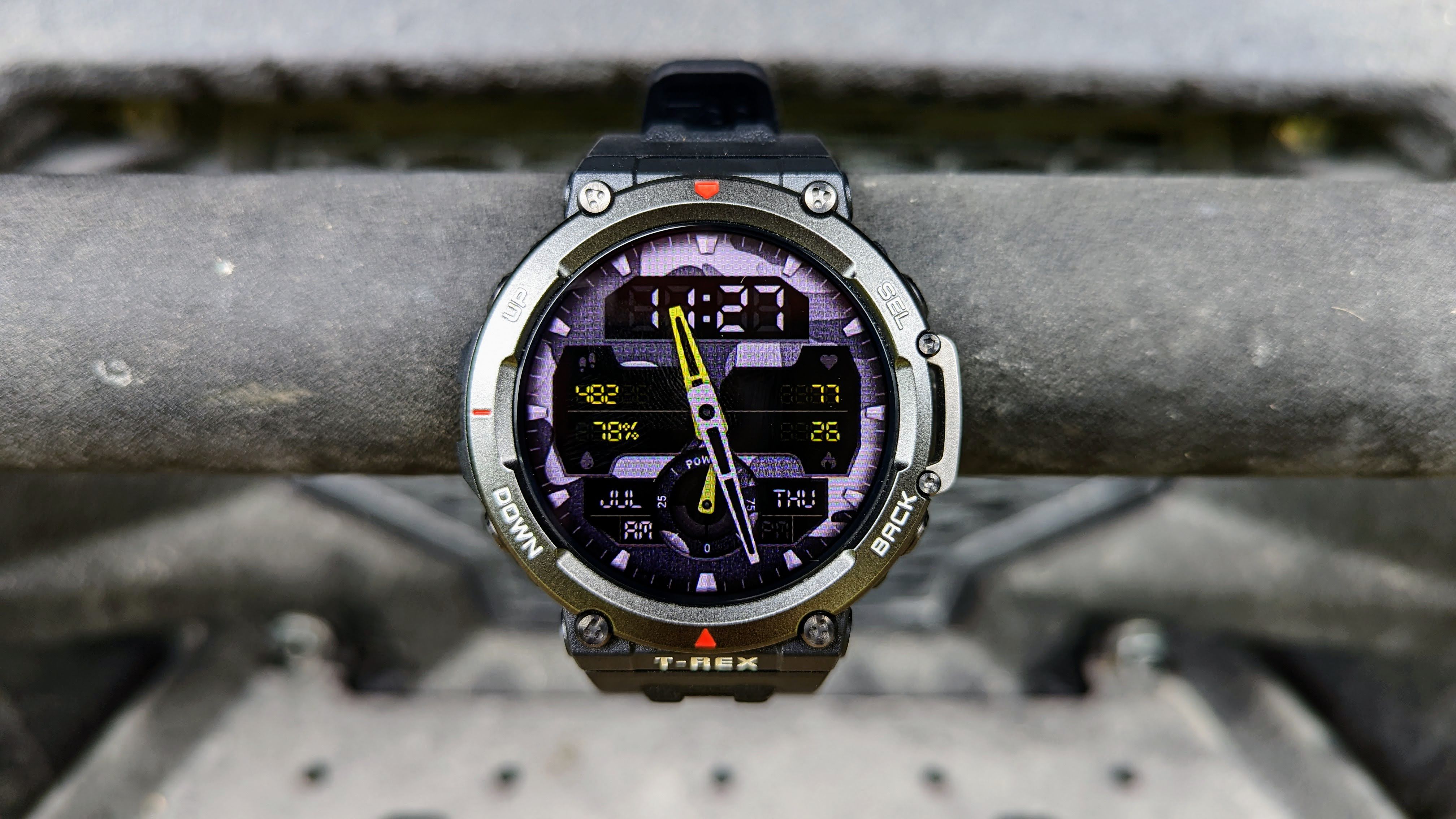Amazfit T-Rex Ultra vs. T-Rex 2: Which should you buy?
The T-Rex Ultra has limited upside over the T-Rex 2 considering the price gap, but it has a few key points to recommend it.

With over 150 sports modes, dual-frequency GPS tracking, 15 MIL-STD-810G test certifications, 24/7 heart and stress monitoring, and epic battery life, the T-Rex 2 has incredible value for its list price. It's not as sleek as the stainless steel Ultra, but it's nearly as tough.
Pros
- Affordably priced for what it offers
- Military-grade durability
- Ultra-bright display
- More colors
- Longer battery life
Cons
- Polymer instead of steel
- No wireless downloads

The Amazfit T-Rex Ultra isn't that different from the T-Rex 2. But thanks to its stainless steel design, it can withstand more water pressure and temperature variation, making it well-suited for diving and mountain climbing. Just be ready for one of the heaviest smartwatches ever.
Pros
- Stainless steel design
- Adjustable lugs on case
- Diving certifications
- Better performance in low temperatures
- Wireless downloads
Cons
- Twice the price
- Massively heavy
Amazfit is best known for its budget watches and trackers, but for those who like Zepp software but want a more high-end experience, the Amazfit T-Rex lineup has you covered. The T-Rex 2 delivers high-quality features at a reasonable $230 price point, while the T-Rex Ultra leaps to $399 largely thanks to more premium materials and a few key software upgrades.
Simply from a price-to-value ratio, the Amazfit T-Rex 2 is your best option, while the T-Rex Ultra costs closer to other premium smartwatches with limited upside. But depending on what you want, the Ultra may still call to you. Let's break down the Amazfit T-Rex Ultra vs. T-Rex 2.
Amazfit T-Rex Ultra vs. T-Rex 2: Design and display

Both the Amazfit T-Rex Ultra and T-Rex 2 have a 1.39-inch touchscreen display with 454 x 454 resolution and 1,000 nits of brightness. Their 326 pixels per inch put them on par with most popular AMOLED fitness smartwatches, including the Galaxy Watch 5 (330ppi).
Each watch also has similar design choices that make them incredibly rugged. They both passed 15 MIL-STD-810G tests, including those for heat, cold, humidity, salt spray, ice, and shock — though only the T-Rex Ultra is "mud-proof." Along with 10ATM water resistance, both watches are rated to survive in 70ºC (158ºF) heat or -40ºC (-40ºF) cold.
For the latter, there's a low-temperature mode active at up to -30ºC (-22ºF) where both watches still function, making them great for mountain climbers or survivalists. Interestingly, the Amazfit T-Rex Ultra lasts five days longer in this mode than the T-Rex 2 (14 days vs. 9 days), despite the T-Rex 2 lasting longer in normal conditions.
Both the T-Rex Ultra and T-Rex 2 share these design perks, the same 22mm silicone watch band, and sport 4 buttons placed at each corner of the display. So where do they differ? Primarily in their materials and weight.

The Amazfit T-Rex 2 uses a hardened polymer alloy for its materials — most fitness smartwatches use polymer over metal because it's lower-weight and saves on costs — but has a "metal-sprayed" bezel.
Get the latest news from Android Central, your trusted companion in the world of Android
Upgrade to the T-Rex Ultra, and you get 316L "marine grade" stainless steel across the bezel, bridge, back panel, and buttons that are designed for chemical or underwater applications — though portions of it still use the same polymer. It can withstand pressure and corrosive compounds and generally looks more stylish. Plus, it has adjustable lugs so that you can ensure the Ultra rests squarely on your wrist.
While the Ultra looks quite stylish, it's also quite possibly the heaviest smartwatch we've ever tested. With the strap, it weighs 89g/ 3.14oz, a full 23g/ 0.8oz heavier than the "chunky" T-Rex 2; it also measures 0.2mm thicker, though at 13.65mm, it's not as thick as some Garmin and COROS watches we've tested.
Frankly, you're going to notice the wrist weight regardless of which Amazfit T-Rex you pick, but the T-Rex Ultra goes beyond what some people will tolerate.
The only other difference worth noting is that the Amazfit T-Rex 2 has more color options than the Ultra. Both have Black and desert-themed options, but the T-Rex 2 has a Wild Green finish and a Black & Gold option with gold-colored buttons.
Amazfit T-Rex Ultra vs. T-Rex 2: Software and sensors
| Header Cell - Column 0 | Amazfit T-Rex Ultra | Amazfit T-Rex 2 |
|---|---|---|
| Dimensions | 47.3 x 47.3 x 13.45 mm | 47.1 x 47.1 x 13.65 mm |
| Weight | 89 grams | 66.5 grams |
| Materials | Stainless steel bezel, back panel, bridge, buttons; Polymer alloy middle frame | Polymer alloy |
| Display | Touchscreen AMOLED, 1.39 inches, 454 x 454 (326 PPI), 1,000 nits | Touchscreen AMOLED, 1.39 inches, 454 x 454 (326 PPI), 1,000nits |
| Colors | Abyss Black, Sahara | Astro Black and Gold, Ember Black, Wild Green, Desert Khaki |
| Operating System | Zepp OS | Zepp OS |
| Buttons | 4 | 4 |
| Strap | 22 mm, silicone | 22 mm, silicone |
| Battery | 500mAh, 20 days (smartwatch mode), 46 hours (GPS only), 28 hours (Dual-band GPS) | 500mAh, 24 days (smartwatch mode), 50 hours (GPS only), 26 hours (Dual Band GPS) |
| Connectivity | Bluetooth 5.0 BLE, WLAN 2.4GHz | Bluetooth 5.0 BLE |
| Sensors | BioTracker 3.0 PPG biometric sensor, acceleration, gyroscope, geomagnetic, barometric, ambient light | BioTracker 3.0 PPG biometric sensor, acceleration, gyroscope, geomagnetic, barometric, ambient light |
| Health tracking | SpO2, heart rate, stress | SpO2, heart rate, stress |
| Trackable sport modes | 162 (33 smart recognition modes) | 158 (33 smart recognition modes) |
| Water Resistance | 10 ATM (100 meters, surface swimming, and snorkeling) | 10 ATM (100 meters, surface swimming, and snorkeling) |
| Durability | 15 MIL-STD-810G certifications | 15 MIL-STD-810G certifications |
| Location | Dual-band 5 satellite positioning | Dual-band 5 satellite positioning |
By and large, both Amazfit T-Rex watches give you the same software experience, from the hundreds of sports modes to the same health data tracked in the Zepp app. The only unique software feature on the Amazfit T-Rex Ultra (and Amazfit Falcon) is the AI Zepp Coach beta, but we can assume the T-Rex 2 will get it eventually.
You get a ridiculous 158 tracked activities on the Amazfit T-Rex 2 across Running, Cycling, Swimming, Dance, Combat Sports, Gym activities, Ball Sports, Water Sports, Winter Sports, and even Board Games like Chess. Both the Amazfit T-Rex 2 and Ultra have automatic Smart Recognition of eight activities — Running, Cycling, Swimming, Indoor/Outdoor Walking, Treadmill, Rowing Machine, and Elliptical — and 25 strength training modes.
With the Amazfit T-Rex Ultra, you get a watch with EN13319 & ISO6245 certifications, meaning it can be used for diving down to 30 meters deep. Even though the T-Rex 2 has a 10ATM resistance (aka 100 meters of water pressure), only the Ultra should really be tested at that depth thanks to its 316L steel.
Plus, only the Ultra has sports modes for Outdoor freediving, Indoor freediving, Spearfishing, and Skydiving. That brings its total sports modes total to 162.

When it comes to location tracking for outdoor activities, both watches have Dual Band GPS on both L1 and L5 frequencies and can connect to two satellite systems at once — both of which are popular settings on many of the best Garmin watches. We tested the GPS Accuracy mode on the T-Rex Ultra and found it quite accurate compared to the Forerunner 265, and the same should hold true with the T-Rex 2.
Both watches will give you 24/7 monitoring of your heart rate, blood oxygen levels, and stress levels. And each has the same sensors, including a barometric altimeter, accelerometer, gyroscope, and compass.
In theory, the T-Rex Ultra could offer more accurate data because the adjustable lugs help it rest flatter on your wrist, but it's also heavy enough that you probably wouldn't want to wear it for sleep tracking.
The main software difference worth noting between them is that the T-Rex Ultra allows Wi-Fi downloads on a 2.4GHz band, whereas the T-Rex 2 relies on the relatively old Bluetooth 5.0 standard. Whether you're uploading your workout data, downloading offline maps, or updating your watch, this data speed boost makes them more convenient.
Amazfit T-Rex Ultra vs. T-Rex 2: Battery life

Both watches have the same 500mAh battery size. That's quite large for a traditional fitness smartwatch, only falling short of a few models we've tested like the Samsung Galaxy Watch 5 Pro and Mobvoi TicWatch Pro 3 Ultra GPS. And it comes across in their longevity.
First, we'll lay out Amazfit's own estimates: the T-Rex 2 lasts 24 days in smartwatch mode, 10 days with heavy use, 50 hours with GPS-only mode, or 26 hours with Dual-Band GPS activated. The T-Rex Ultra drops to 20 days in smartwatch mode or 9 days with heavy use, along with 46 hours for GPS-only mode. The Ultra does slightly better with Dual-Band GPS, hitting 28 hours.
In practice, our T-Rex 2 reviewer "enabled all of the health features to monitor 24 hours, always on display, and used automatic sleep tracking every night," as well as some GPS-tracked workouts, and hit "nearly two weeks of battery life." Evidently, he'd need to use the T-Rex 2 even more frequently to hit Amazfit's 10-day estimate.
We haven't fully tested the T-Rex Ultra battery yet, but it's clear that the watch does tend to use more battery when idling. Still, you can typically count on this watch to last far longer than most competing fitness smartwatches.
Both watches use a proprietary magnetic charger and should jump back to full in a couple of hours.
Amazfit T-Rex Ultra vs. T-Rex 2: Which should you buy?

Most of the unique T-Rex Ultra features we managed to spot — scuba diving certification, mud-proofing, better low-temperature battery life — are the definition of "niche." Extreme outdoor sports types may want to upgrade, but for people using the other hundreds of sports modes out there, the T-Rex 2 checks off all of your boxes for significantly less.
You can choose the Amazfit T-Rex Ultra for its stainless steel design and the adjustable lugs, which helps you wear it more loosely for everyday use and then swap to a tighter fit during a workout. You'll have to get used to the weight, but anyone used to the larger Garmin Fenix or Enduro models won't find it too much heavier, and it'll save you hundreds compared to those watches.
Still, if you consider the best Amazfit smartwatches, most of them have reasonable price tags, and the T-Rex 2 fits the bill better on that front. We wish it had wireless downloads like the Ultra, but we can bear slower updates at this price point.

Choose the Amazfit T-Rex 2 if you want a lighter smartwatch design, along with a ton of useful fitness modes and software for less. Don't choose it if you want the Ultra's fancier look or can't stand slow download speeds.

Choose the Amazfit T-Rex Ultra if you're a diver or rugged outdoorsman who wants the best possible protection from the elements, or if you really care about aesthetics. Don't choose it if you can't stand heavy watches or you're on a budget.

Michael is Android Central's resident expert on wearables and fitness. Before joining Android Central, he freelanced for years at Techradar, Wareable, Windows Central, and Digital Trends. Channeling his love of running, he established himself as an expert on fitness watches, testing and reviewing models from Garmin, Fitbit, Samsung, Apple, COROS, Polar, Amazfit, Suunto, and more.
